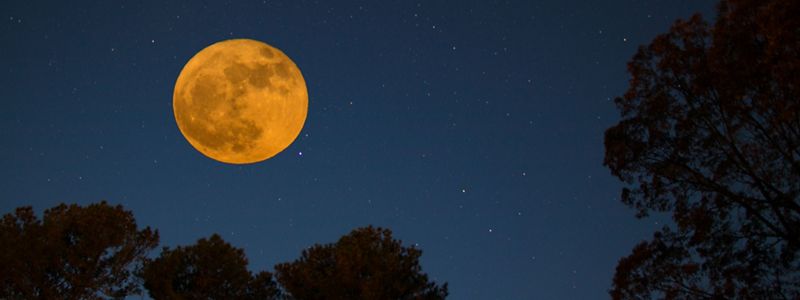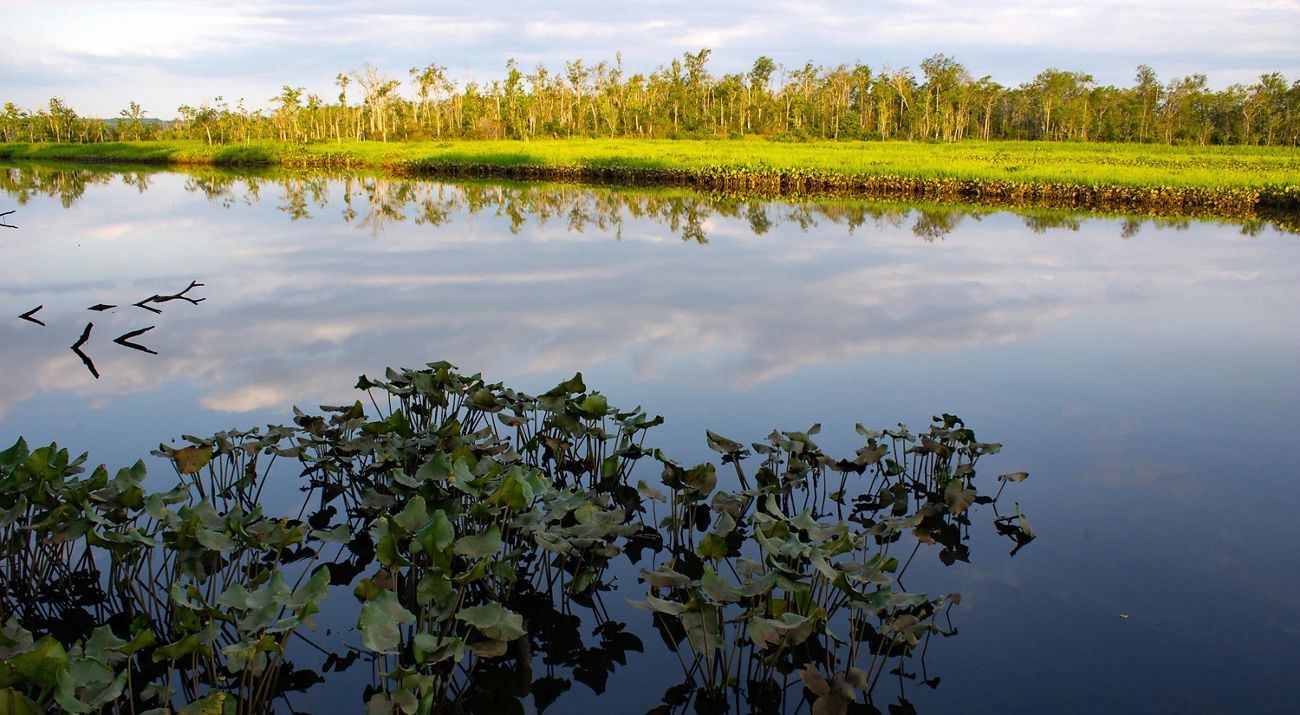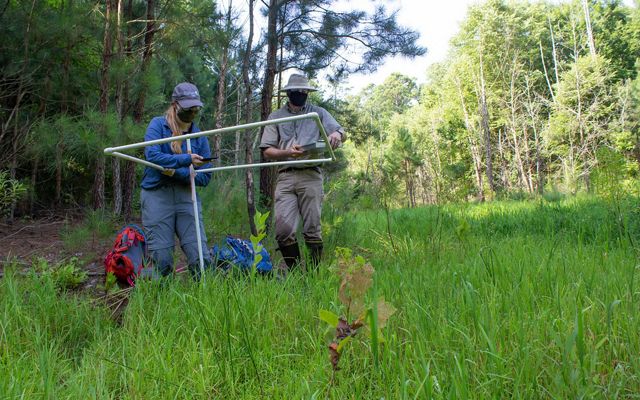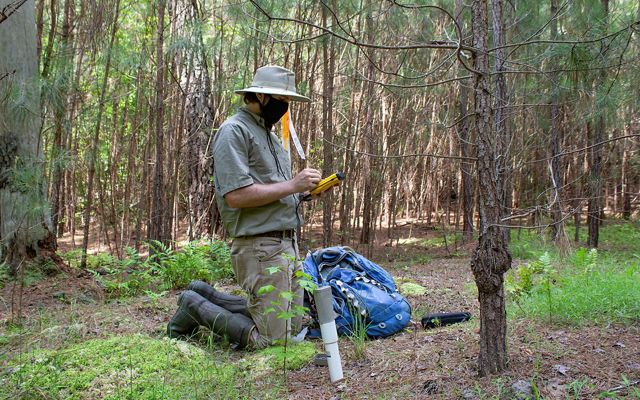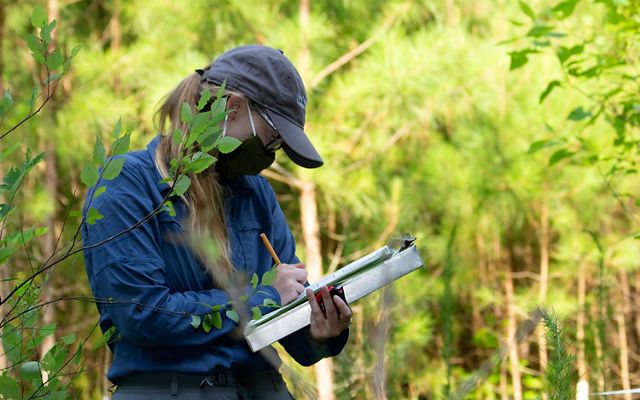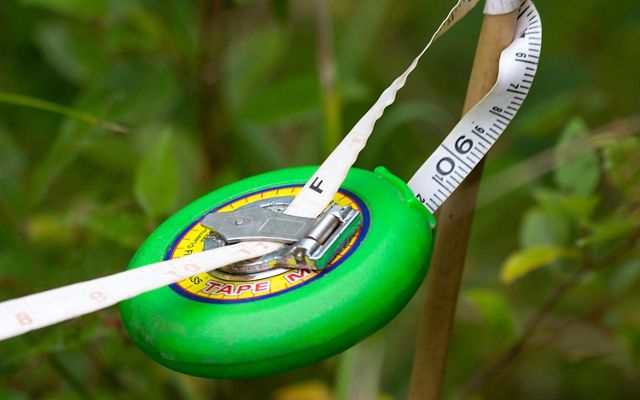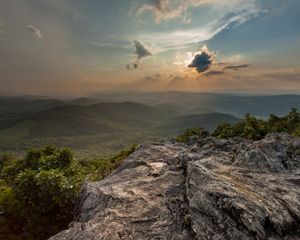In Water We Trust
The Virginia Aquatic Resources Trust Fund marks a quarter century of restoring wetlands and streams.
Sunrise and soybeans. The first rays of the former reach down long rows of the latter, transforming dull olive green to shimmering emerald. A cacophony of birdsong emanates from a wall of woods. For nearly an hour, the trees will keep the sunlight from splashing across Holts Creek and burning off tendrils of hovering mist.
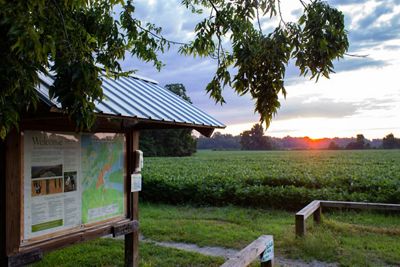
I’m at the entrance to The Nature Conservancy’s Vandell Preserve at Cumberland Marsh, more than 1,000 acres of protected wetlands and forest near New Kent, Virginia. Turning away from the nearby boardwalk and its scenic views of creek and marshes, I follow a trail that winds around the bean field and then enters the woods.
I’m scanning the trailside for a flagged tree when I hear a voice, and a man wearing a black mask under a broad-brimmed hat steps out of the trees and onto the trail. I’ve passed our meeting point, but Alex Fisher heard me coming. A field ecologist with TNC’s Virginia Aquatic Resources Trust Fund, Alex has agreed to show me around on this summer morning and explain how the trust fund team conducts longterm monitoring after restoration projects.
Quote: Michael Lipford
It’s our people who made this program work—and our continuity of purpose.
A short bushwhack takes us into a grassy bowl with scattered shrubs and young trees. A narrow stream, barely wider than a footstep, cuts through the center of this spongey meadow. Alex and teammate Lindsay Schneider, who’s sporting an olive-green mask beneath her TNC ballcap, are systematically measuring out a series of sample plots across the entire clearing.
Within each plot, the duo identifies every plant species, counts the specimens and calculates their size and the percentage of ground they cover. Additionally, Alex collects data from hydrologic wells to document daily fluctuations of groundwater. This information helps TNC measure progress toward reestablishing healthy wetland systems and plant communities.
This monitoring process recurs at least five times during the decade following each wetland or stream restoration. At Cumberland Marsh, two dams were removed nearly a decade ago, so Alex and Lindsay’s inventory may be one of the last assessments of how the plant life has responded here, including designed plantings of native shrubs and trees.
A highlight of this restored wetland is the earlier discovery of a new population of sensitive joint-vetch. This rare legume, which sports attractive yellow blossoms in the spring, wasted little time spreading into an area that had previously been covered by a dammed impoundment.
Evolution of The Trust Fund
There was a time when buying swampland, like purchasing the Brooklyn Bridge, supplied a punchline for countless jokes. Over the last 25 years, though, the Virginia Aquatic Resources Trust Fund has proven the wisdom of investing in wetlands and streams and in restoring the natural services they provide to everyone, such as cleaning our water, reducing floods, creating habitat and providing outdoor recreation.
When the trust fund launched in 1995, it presented a straightforward option for developers whose projects impacted small, scattered wetlands (generally less than an acre). Instead of attempting on-site measures of dubious quality and benefit, developers could mitigate damages by paying fees set by the U.S. Army Corps of Engineers. TNC would then use those pooled resources to undertake larger-scale conservation projects in places identified as priorities.
The trust fund’s early years focused on restoring the Green Sea Wetlands of southeastern Virginia, enhancing habitat as well as natural water filters in the river systems that provide drinking water for the people of Hampton Roads. In 2003, the program expanded to include stream projects. One of the most complex stream restorations ever undertaken in Virginia involved protecting new city parkland and restoring approximately two miles of Charlottesville’s Meadow Creek.
The program has also evolved to keep current with legal and regulatory changes, as well as to engage more partners. Today, the Virginia Department of Environmental Quality is a co- administrator, and TNC’s trust fund team regularly consults with experts from myriad agencies and organizations. Tribal representatives also are participating, most recently weighing in on a project at Cedar Creek Battlefields in the Shenandoah Valley.
“From a relatively small cumulative impact, our Virginia Aquatic Resources Trust Fund has conserved more than 20,000 acres, nearly half of which is now public land,” director Karen Johnson says, summing up the program’s accomplishments. These sites include state natural area preserves such as Crow’s Nest and Ogdens Cave in Northern Virginia, as well as lands managed by the cities of Harrisonburg and Fredericksburg.
“We’ve also prevented tons of sediment from polluting streams and served as a mitigation model that's being emulated in states such as Ohio and Utah,” Johnson says. Looking to the trust fund’s next quarter century, Johnson adds, “I’d like to leverage our 25 years of experience to replicate the success of TNC’s Fire Learning Exchange, but for wetland and stream mitigation and restoration.”
Quote: Karen Johnson
From a relatively small cumulative impact, our Virginia Aquatic Resources Trust Fund has conserved more than 20,000 acres, nearly half of which is now public land.
Trust Fund Highlights
From such a range of conservation projects covering 25 years, how does one choose the most significant highlights? What criteria do you use?
I decided to ask members of the team—not only which projects they consider program milestones, but also which sites hold some sort of personal significance. Read on for a sampling of their responses.
Diane Frisbee, Stream Mitigation Manager
The City of Fredericksburg project ranks high on my list. In partnership with the city, Virginia Outdoors Foundation and Virginia Department of Wildlife Resources, we protected over 4,000 acres along the Rappahannock and Rapidan rivers, including miles and miles of river and stream frontage. It’s a fun and beautiful place to explore by kayak or canoe, and it gets a lot of public use. A great example of people and nature thriving together!
Another one that has been meaningful to me personally is Charlottesville’s Meadow Creek, our largest and most urban stream restoration project. Working right in our back yard and with many partners I have known for years has been rewarding. We’ve also engaged a lot of volunteers and enabled numerous educational and research opportunities with UVA and local public schools.
Alex Fisher, Wetland Restoration Ecologist
One site that has brought joy and hope to me is Level Ponds on the Eastern Shore. An appreciation for all the other beings sharing that space overwhelms me as I enter and wade into standing water: ducks, geese, myriad songbirds, snakes, frogs, insects and plants (the foundation for all this life). Located 5,000 feet upstream from the Chesapeake Bay, this site and its conversion back to wetlands are improving water quality, expanding needed wetland habitat, and strengthening the resilience of nearby human communities.
Chris DuBois, Restoration Coordinator
The Oscar Jennings and Evelyn Lilly Blake Preserve (AKA Mill Creek Springs Natural Area Preserve) near Blacksburg is one of the first sites that I visited after starting work with the trust fund. Highlights for me include unique karst features and a beautiful mountain stream, Mill Creek. And my first encounter with black bears in Virginia occurred on this property early one morning when a sow and two cubs crossed a gravel road about a hundred yards in front of me. I love walking through the woods and along the stream at the Blake Preserve, and I always go home feeling better.
Michael Lipford
(Former Virginia State Director and TNC Southern Division Director (retired) and a co-creator of the trust fund.)
From a conservation standpoint, we protected a lot of really special places with this funding source. The Nature Conservancy created a mitigation network, we told the success stories through that network and that has stimulated action in other places. I want that to continue, and I want TNC to be best in class so that, through our science, we do projects that help avoid impacts, we help offset them and we choose places that will stand the test of time. I’ll just add that it’s our people who made this program work—and our continuity of purpose.
Stay In Touch
Sign up to receive monthly conservation news and updates from Virginia. Get a preview of Virginia's Nature News email
